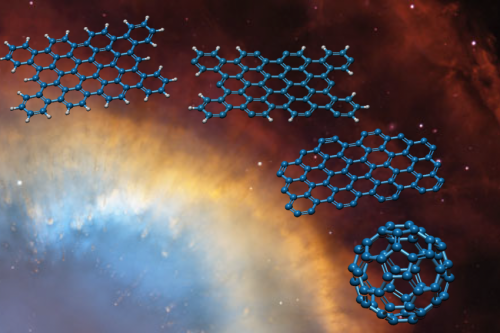Molecular striptease explains Buckyballs in space

Scientists from Leiden University have shown in the laboratory how Buckyballs - molecular soccerballs - form in space. The experiments are special, as these are based on a new chemical concept - top-down, from big to small - transfering large aromatic species into interstellar graphene, fullerenes and carbon cages.
C60 Buckminsterfullerenes were discovered in space in 2010, nearly 15 years after the Nobel Prize was awarded for their discovery in the laboratory. With this discovery, C60 also became the largest identified molecule in the interstellar medium. Unclear, however, was how such a complex molecule could form. Because of the highly dilute nature of matter in space, it is very unlikely that it forms in a series of sequential steps, building up from smaller species. An answer to this question has been found in the Laboratory for Astrophysics at Leiden Observatory. The results have been accepted for publication in the Astrophysical Journal Letters.
Dying stars expell large amounts of so called PAHs, polycyclic aromatic hydrocarbons. These are the same particles that are emitted on Earth by cars, contributing to air pollution. A PAH comprises of a generally flat carbon skeleton with H-atoms at the edges. They are expected to be omnipresent in space as their spectral fingerprints are visible everywhere in the Universe.
In Leiden a new setup has been constructed - iPOP (Instrument to study Photodynamics of PAHs) that is used to catch very large PAHs in a molecular trap. The scientists at Leiden Observatory subsequently irradiated the PAHs with light and discovered that once a PAH is put into the spotlights, it starts with a molecular striptease, stripping off H-atoms one by one, until the naked carbon skeleton is left over. This is nothing else than a graphene flake.
Lead author Dr. Junfeng Zhen and PhD students Pablo Castellanos Nash and Daniel Paardekooper explain: "The experiment starts with a GRAND-PAH, a very large PAH, for example C66H26, then the molecule is ionized, and trapped in an ion trap. The trapped species are irradiated by ligth and fragment. Once the trap is opened, a sensitive mass spectrometer is used to visualize which species have been formed. We find all steps from the precursor species up to the fully stripped molecule, as well as new reaction products".
The PIs, Profs. Xander Tielens en Harold Linnartz are very enthusiastic about the fact that among the reaction products also C60 can be found. "The experiments show that it is possible to transfer PAHs into molecular soccerballs, and this can explain why we find C60 in space. The experiments also show that the chemical complexity in the interstellar medium not necessarily has to be explained by merging smaller components, the fragmentation of a large precursor may be equilly important", according to Tielens.
It is very well possible that the researchers have digged into a goldmine. The new experiments make it possible to generate exotic molecules, carbon cages, fullerenes and graphene flakes, species that so far could not be investigated under isolated conditions. Space may be littered with these exotic species. Indeed, meanwhile also C70 - a molecule in the form of a rugby ball - has been identified in the interstellar medium, and also here lab data hint for a formation from even larger PAHs. Linnartz: "We now wait for the detection of interstellar graphene".
More information: Laboratory formation of fullerenes from PAHs: Top-down interstellar chemistry. Junfeng Zhen, Pablo Castellanos, Daniel M. Paardekooper, Harold Linnartz, Alexander G. G. M. Tielens; Astrophys. J. Letters, arxiv.org/pdf/1411.7230v1.pdf
Journal information: Astrophysical Journal Letters
Provided by Leiden University

















